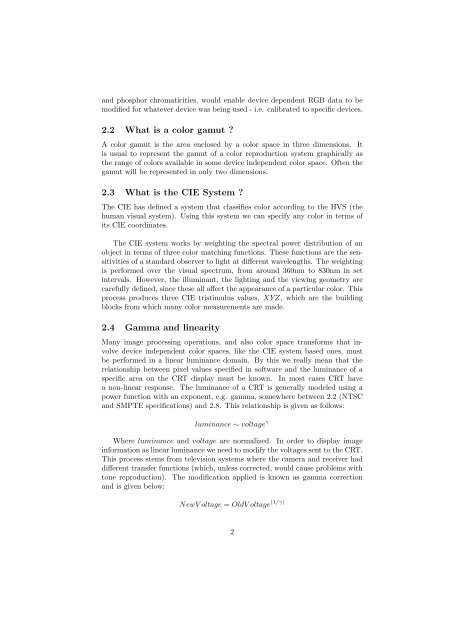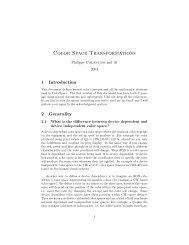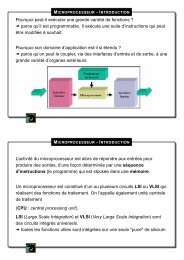Download Color Space Transformations - Nerim
Download Color Space Transformations - Nerim
Download Color Space Transformations - Nerim
You also want an ePaper? Increase the reach of your titles
YUMPU automatically turns print PDFs into web optimized ePapers that Google loves.
and phosphor chromaticities, would enable device dependent RGB data to be<br />
modified for whatever device was being used - i.e. calibrated to specific devices.<br />
2.2 What is a color gamut <br />
A color gamut is the area enclosed by a color space in three dimensions. It<br />
is usual to represent the gamut of a color reproduction system graphically as<br />
the range of colors available in some device independent color space. Often the<br />
gamut will be represented in only two dimensions.<br />
2.3 What is the CIE System <br />
The CIE has defined a system that classifies color according to the HVS (the<br />
human visual system). Using this system we can specify any color in terms of<br />
its CIE coordinates.<br />
The CIE system works by weighting the spectral power distribution of an<br />
object in terms of three color matching functions. These functions are the sensitivities<br />
of a standard observer to light at different wavelengths. The weighting<br />
is performed over the visual spectrum, from around 360nm to 830nm in set<br />
intervals. However, the illuminant, the lighting and the viewing geometry are<br />
carefully defined, since these all affect the appearance of a particular color. This<br />
process produces three CIE tristimulus values, XYZ, which are the building<br />
blocks from which many color measurements are made.<br />
2.4 Gamma and linearity<br />
Many image processing operations, and also color space transforms that involve<br />
device independent color spaces, like the CIE system based ones, must<br />
be performed in a linear luminance domain. By this we really mean that the<br />
relationship between pixel values specified in software and the luminance of a<br />
specific area on the CRT display must be known. In most cases CRT have<br />
a non-linear response. The luminance of a CRT is generally modeled using a<br />
power function with an exponent, e.g. gamma, somewhere between 2.2 (NTSC<br />
and SMPTE specifications) and 2.8. This relationship is given as follows:<br />
luminance ∼ voltage γ<br />
Where luminance and voltage are normalized. In order to display image<br />
information as linear luminance we need to modify the voltages sent to the CRT.<br />
This process stems from television systems where the camera and receiver had<br />
different transfer functions (which, unless corrected, would cause problems with<br />
tone reproduction). The modification applied is known as gamma correction<br />
and is given below:<br />
NewV oltage = OldV oltage (1/γ)<br />
2




